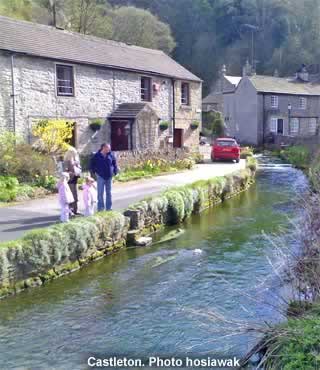Castleton |
|
 |
|||
Britain > Peak District > Castleton |
||
A town with precious stones, a ruined castle, and the Devil's rear end |
||
The Hope Valley is a dramatic and varied section of the Peak District. It links the gritstone moors in the west with the limestone peaks in the east, and contains elements of both landscapes. |
||
The valley also used to be home to the Royal Peak Forest, a hunting ground for the nobility. Shortly after William the Conqueror took over the country, he granted control of these woods to his illegitimate son, William Peveril. In order to more easily govern the area, Peveril built himself a castle on a high hill. The resulting fortress was in such a good location that it was considered to be completely impregnable. |
||
As was common, houses soon began to collect around the new castle. In time this small gathering of buildings grew into a full town. The people who named this new settlement obviously didn't have much imagination, as they simply squashed the words "castle" and "town" together. |
||
Over the last millennium, the Royal Peak Forest has significantly receded. However, Peveril Castle remains standing and is still the major landmark of the town it created. If it was attacked now though, it certainly wouldn't be impregnable! It's become a forlorn, ruined structure, gazing out mournfully across the land it once held power over. |
||
Beneath Peveril is another breath-taking sight - one that's been there for even longer than the castle. This is Peak Cavern, which is part of the most extensive network of caves in the Peak District. Its entrance is the biggest cave mouth in Britain, and the second-biggest in the entire world. It's so big that, in the past, rope makers actually built their houses inside it. The damp conditions were beneficial for their craft. The industry continued for 500 years, only ending in 1975 when the very last rope maker retired. His name was Bert Marrison, and he was 91 years old when he finally put down his tools. In accordance with his wishes, Bert's ashes were buried inside the cavern. |
||
In truth, the cave has been using a fake name for several decades now. It was changed to "Peak Cavern" for the royal visit of Queen Victoria, because the locals wanted to spare her embarrassment. The true, historical name of the cave is the Devil's Arse. If this hasn't put you off, then you're free to climb inside. The Devil's Arse is one of Castleton's four show caves. |
||
The three others are less interestingly named, but their interiors are just as impressive. Speedwell Cavern is flooded, so it has to be explored by underground boat. Treak Cliff, meanwhile, is famous for its stalactites and stalagmites. The last of the show caves is called Blue John. Its name comes from a semi-precious mineral which is still mined there. This unusually-coloured stone can be found nowhere else in the world. It has been made into all sorts of ornaments, from jewellery to cutlery. These objects have found homes in such distinguished places as the Vatican, and the White House. You can buy similar items for yourself in one of Castleton's many gift shops. |
||
Blue John cavern can be found in the shadow of Mam Tor, a large hill that overlooks Castleton. Its name literally means Heights of the Mother, although its more popular nickname is the Shivering Mountain. This comes from the layers of loose stone on its surface, which can often crumble - making the hill appear to shiver. It's a feature that makes Mam Tor a dangerous place to be. There used to be a road on its southern side, but it was closed in 1979. Due to land slippage, the road was dramatically split in two with one side considerably out of line with the other. With care this can be visited but remember to look out for falling rocks! |
||
At the summit of Mam Tor, you'll find the remains of an Iron Age hill fort. The view from the top, over Castleton and the rest of the Hope Valley, is one that has been enjoyed for hundreds of years. This spectacular location is also used as a jumping off point for hang gliders. |
||
|
||
Peveril Castle is open daily, 10am to 5pm (limited in winter). Entry costs around £4 for adults, £2 children. Castleton, S33 8WG. Tel: 01433 620613 |
||
Speedwell Cavern is open daily, 10am to 5pm. Trips cost around £8 for adults, £6 children. Winnats Pass, S33 8WA. Tel: 01433 620512 |
||
Treak Cliff Cavern is open daily, 10am to 4pm (limited tours in winter). Trips cost around £8 for adults, £4 children. Castleton S33 8WP. Tel: 01433 620571 |
||
Blue John Cavern is open daily, 9.30am to 5pm. Trips cost around £8 for adults, £4 children. Buxton Road, Castleton S33 8WP. Tel: 01433 620638 |
||
Peak Cavern is open daily, 10am to 5pm (limited tours in winter). Trips cost around £7 for adults, £5 children. Castleton S33 8WS. Tel: 01433 620285 |
||
|
Pocket Britain is optimised for use on a smartphone or tablet with internet access. All content is subject to copyright. All reasonable methods have been used to ensure information supplied is accurate at the time of publication. However, it is advisable to check information before relying on it. Privacy Policy |